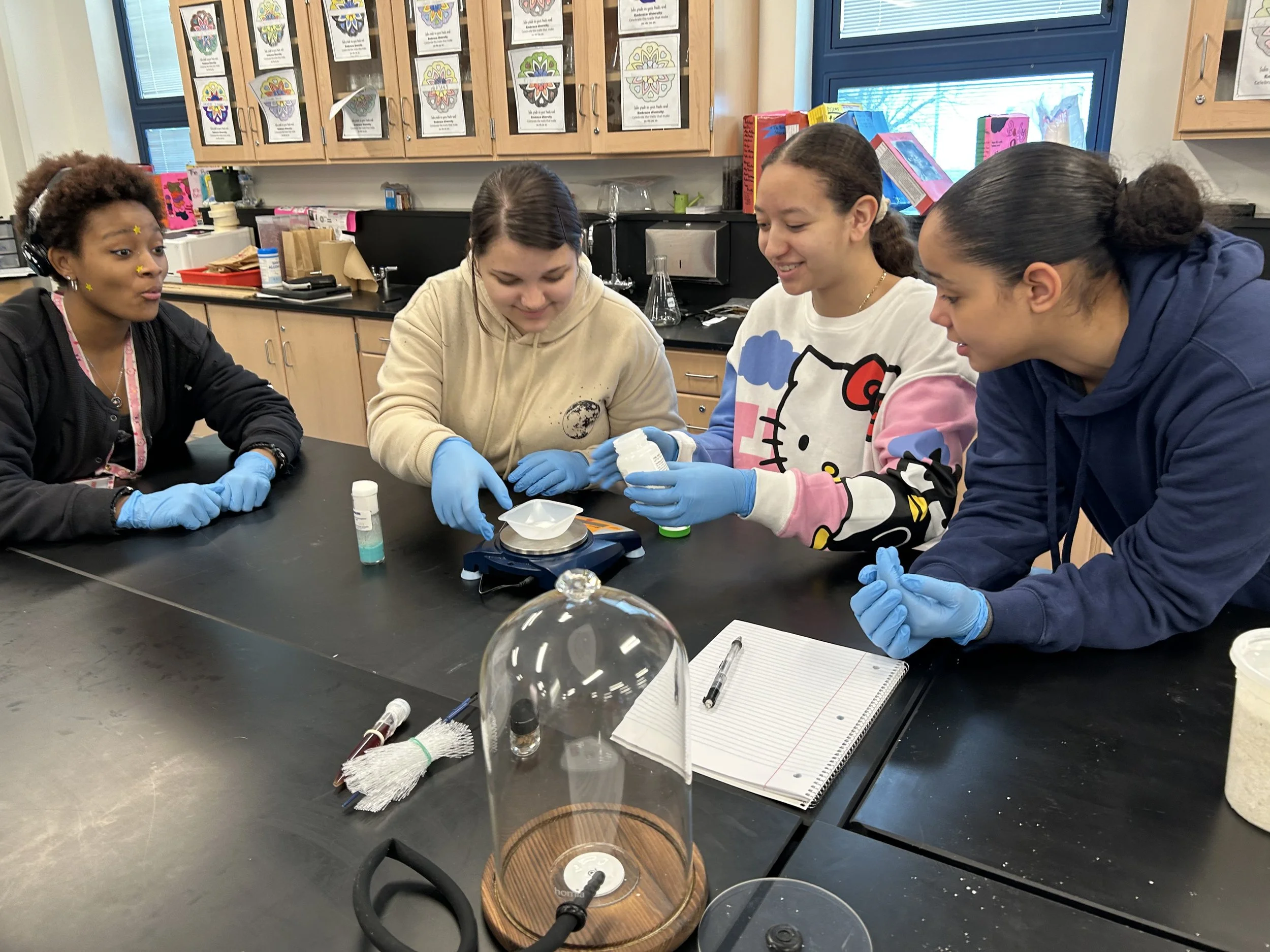February 2025
Students mixing vape chemicals with fly food
Full steam ahead!
Hands-on experiments have officially begun at Garrett Morgan School of Engineering and Innovation! We are thrilled that 7 more innovative projects are underway with 9th and 10th grade students. This month we will do a deep dive into one of the projects: Vaping While Pregnant!
As vaping continues to grow in popularity, concerns about its potential health effects—especially during pregnancy—remain largely unanswered. Our latest research project, conducted using fruit flies as a model organism, aims to shed light on how vaping impacts reproductive health and pregnancy outcomes. While fruit flies may seem far removed from humans, their biological processes related to reproduction share surprising similarities with ours, making them a valuable tool for scientific study.
This project explores how exposure to vape juice and nicotine affects key reproductive factors, such as fertility, egg-laying behavior, and sperm health. By conducting a series of carefully designed experiments, we hope to provide new insights into the potential risks of vaping—insights that could be particularly relevant for expecting mothers and public health policymakers.
What are we studying?
This project consists of five major tests, each designed to answer critical questions about the effects of vaping on reproductive health:
Egg-Laying Behavior (Fecundity): We examine whether vaping exposure affects a female’s ability to lay eggs. By comparing egg counts between flies exposed to vape substances and those in a controlled environment, we can assess potential reproductive challenges.
Fertility Rate (Larval Development): Does vaping impact the ability of fertilized eggs to develop into healthy larvae? By measuring the number of larvae that emerge from eggs, we assess whether exposure to vape juice and nicotine alters fertility outcomes.
Olfactory Function (Sense of Smell): The sense of smell is crucial for fruit flies in finding food and mates. We conduct a Y-maze experiment to determine whether vaping affects olfactory preference, which could indicate neurological impacts beyond reproductive concerns.
Female Reproductive Health: To investigate whether vaping leads to physiological changes in reproductive organs, we analyze the pH levels of the female reproductive tract. Shifts in pH could indicate oxidative stress, inflammation, or disruptions to reproductive function.
Sperm health and viability: Male fertility is also a key concern. Our study examines whether vaping exposure affects sperm count and quality, using specialized staining techniques to distinguish between live and damaged sperm cells.
Why this matters
The potential effects of vaping during pregnancy are still not well understood, yet millions of people—including expecting mothers—use e-cigarettes under the assumption that they are safer than traditional smoking. Our research seeks to fill this gap by providing scientific evidence on how vape chemicals may influence reproductive health.
This study could have broad implications for public health, guiding future recommendations for pregnant individuals and those trying to conceive. If vaping is found to have negative effects on fertility and reproductive outcomes, it may prompt further discussions on regulations, warnings, and alternative cessation methods for those looking to quit smoking.
Measuring chemicals
Lincoln-West update
It was a busy and productive February at Lincoln-West! We are excited about the growth students are showing, they are truly becoming the experts in their field of research! Today we will highlight group #49 Acid Effects:
Every day, countless people—chefs, scientists, factory workers, and more—handle acidic substances as part of their jobs. But what happens if they have an open wound while working with these chemicals? Could exposure to acids slow down the healing process or even cause further damage? This research project aims to answer these questions by investigating the effects of acidic solutions on wound healing.
Using earthworms as a model organism, this study explores how different levels of acidity impact tissue regeneration. While worms might seem an unusual choice, they are widely used in wound-healing research due to their remarkable ability to regenerate tissue, offering insights applicable to human biology. The research is structured into three key experiments:
1. Establishing a wound-healing baseline
Before testing acid exposure, we first need to understand how wounds normally heal in earthworms. In this trial phase, we carefully make small incisions on the worms and observe their healing progress. By measuring wound size and recording visual changes over time, we establish a baseline for comparison.
2. Testing acid exposure on wounds
Once we understand the normal healing process, we introduce different acidic solutions—including lemon juice, vinegar, and malic acid—in varying concentrations. Each wounded worm receives a controlled amount of acid treatment daily. The goal is to determine whether exposure to acidic environments affects healing speed and tissue recovery.
At the end of the study, we conduct a Western blot analysis to measure levels of vascular endothelial growth factor (VEGF), a key protein involved in tissue repair. This will help us determine whether acidic exposure disrupts the biological mechanisms of healing.
3. Studying Long-Term Exposure Effects
Unlike the previous experiment, which involves direct acid application, this phase examines whether prolonged exposure to an acidic environment affects healing. Instead of treating wounds with droplets of acid, we replace the worms’ soil with acidic solutions, simulating long-term exposure conditions. This method mimics real-world situations where workers may constantly handle acidic substances over extended periods.
Why this research matters
This study has the potential to impact workplace safety and healthcare guidelines. If acid exposure is found to slow down wound healing, individuals working with acidic chemicals may need to take extra precautions when handling substances with open wounds. The research could also contribute to medical treatments for burn victims and individuals with chronic wounds.
Stay tuned for updates on our findings, and follow us as we uncover new insights into the science of healing!
Worm dissection


